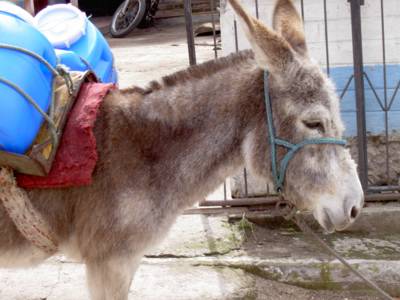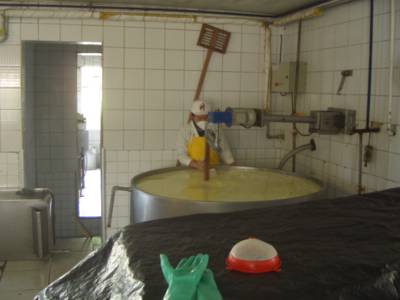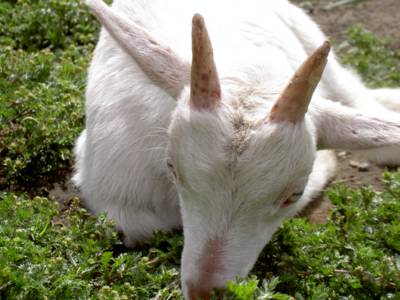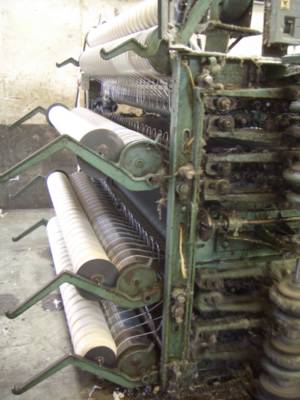There is a very small Ecuadorian town called Salinas that, on the surface, mirrors these same sentiments. Salinas is home to both a cheese factory and a chocolate factory. So, it was entirely within character for Tom to choose Salinas as our next stop en route back to Cuenca. We left the PanAmerican highway and headed a bit west to see how cheese and chocolate are made.
In the toursit office, we were confronted with a hand-drawn map on the wall that displayed a directory of cooperative businesses, rather than a directory of factories. This was a hint that we had arrived someplace that was reinventing itself.
Thirty years ago, Salinas was just another rural village situated in a wild mountain landscape. Although it still maintains these characteristics, today there are 30 cooperatives operating here. First we visited an herb processing plant. They dry herbs. They make herbal oils. They also produce shampoos, balms, essential oils, and most anything to do with herbs. One of the workers explained each step in each process and the various equipment used. Perhaps due to the availability of props in a factory setting, we didn't have much difficulty understanding these explanations in Spanish. Another worker explained the medicinal uses of some of the products they sell. We had immediate interest in the curabena balm touted for its acne fighting abilities and bought two.
Next, we headed down the street to visit the cheese factory. On the way, we came upon the first step in the process.
A donkey carrying two large blue kegs of milk stood patiently in the street. We had seen women carting these heavy blue kegs on and off the bus up the mountain from Guaranda. These blue kegs are used to transport fresh milk to the factory. At the factory, the first step is pasteurization. Once pasteurized, the milk flows through pipes into a large vat, where various heating, mixing, and culturing steps take place.
 |  |
Molds are used to form the final shape of the cheese rounds and, in some cases, squares. The resulting fresh cheese is what I had been eating in many typical Ecuadorian dishes. The factory produces 4 different types of aged cheese, only one of which was familiar to me - Gruyere.

The rounds and squares are stored in rows in racks that are visually appealing.
 |  |

Our guide explained that the owners of the cheese factory meet once a year to make management decisions. These meetings are quite an affair, because there are about 2000 owners. Now at this point, we had seen maybe 3 or 4 workers in the entire place. How could there be 2000 owners? It turns out that the milk producers (the cow owners, not the cows) are the owners and control the operation of the plant. The factory workers are employees. In an agrarian society, this makes perfect sense, but it was out-of-the-box thinking for me.
Next, our guide brought us to a similar enterprise in its pilot stages, where they produce goat cheese. We visited with the goats, who really do eat everything. They developed an immediate fondness for my pants and TM's shoelaces.
 |  |
These goats are not native to the area and find it a bit too cold. The first batch of baby goats did not make it through their first winter outdoors. The owners have some new assimilation strategies planned for this second batch of youngsters.
While in Salinas, we also visited a factory where they make soccer balls. I thought this would require a building with heavy-duty machinery to produce something so rugged. As it turns out, the factory was contained in a small room, where 5 people worked.
Two people sat wrapping "rubberized" string around a balloon.
The wrapped balloons were then dipped in small bucket of "liquid rubber" and allowed to dry.
One small machine was used to punch out the "adhesive backed leather" into pentagons to create the familiar shapes and colors found on soccer balls.
 |  |  |
Finally, heat was applied to adhere the exterior leather. These soccer balls looked just like any other soccer ball, but I could not attest to their quality; I did not have a chance to kick one around a bit.
Eventually, we visited the chocolate factory. This factory was not a collective. Our guide called it a project to create jobs for the local people. I have been on a few food-related factory tours in the U.S. At the end, you always get to taste a little, whether it's chocolate or beer or bagels. And then you have the opportunity to buy as much as you want. Although I didn't expect to taste a soccer ball, I definitely had my hopes pinned on a little chocolate. No such luck. In fact, none of the factories offered us any tastes. Had there been a suggestion box at the tourist office, I would have made a marketing suggestion concerning providing tastes to the tourists. As it is, my first suggestion would be for a suggestion box.
The yarn factory was quite interesting. Although our guide had indicated that all the craft-related factories produced hand-made goods, yarn was produced using very large machines. No hand carding and spinning here. The machines tended to be intricate and looked to me like they were custom designed.
First, the wool was washed and dried using many large machines in some dark and dank rooms.
Once dried, the wool was died, if necessary. Any sorting was done by hand. The clean, sorted, and dyed wool was then fed through several elaborate machines to make yarn.
 |  |


Outside, Salinas residents made abundant use of the natural resources available. The "sal" in Salinas means salt in Spanish. How did this land-locked town with no ocean nearby produce salt? Our guide pointed to some exposed red rock that collects water, which forms salt as it dries. On one of the hilltops, I could see a tree farm that had been partially mined.
We also visited a ceramics factory, a tagua-nut button factory, a beadwork factory, a mushroom factory (as in dried mushrooms, mushroom noodles, mushroom soup). In deference to the vegetarians amongst us, we skipped the sausage factory. Finally, our guide brought us to the store on the main square. Calliope and I were intent upon buying a wool sweater, but there was only one size - very wide. Without having an opportunity to taste anything, we bought 4 rounds of Andino cheese, 3 bags of mushroom noodles, and 5 large bars of chocolate. Update: all three were fairly non-descript flavor-wise.

No comments:
Post a Comment